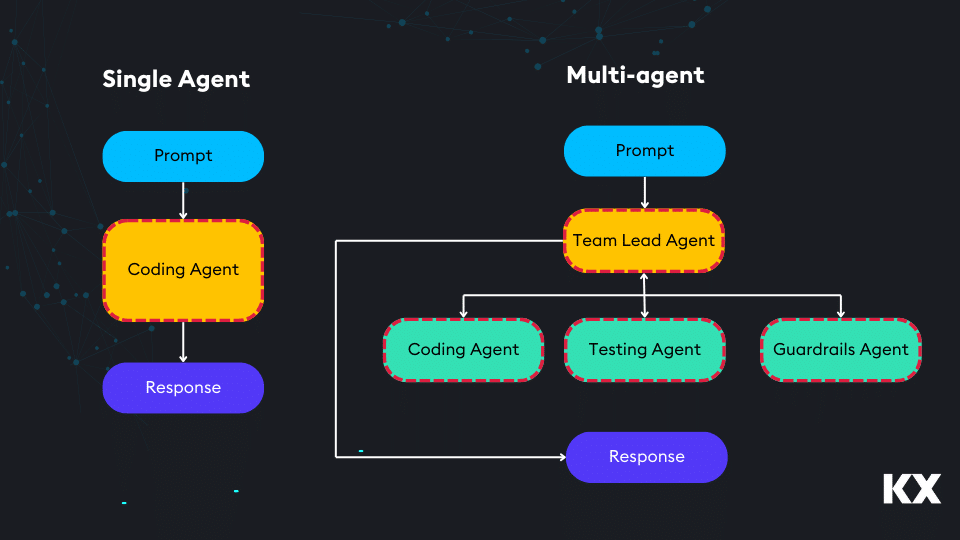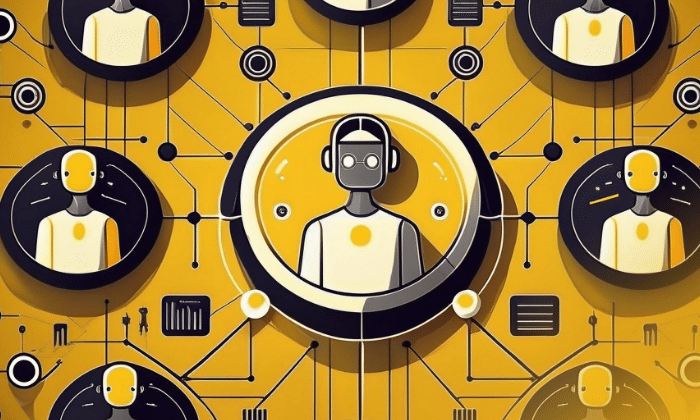Over the past few months, we have been exploring how a factory-like approach to AI adoption can help ensure you have a data strategy and culture that allows your teams to run deeper, more creative analysis using unstructured data. In this blog KX Data Scientist Ryan Siegler considers how incorporating multi-agent AI frameworks could transform your business practices and further enhance how you extract value from unstructured data.
Multi-agent AI frameworks offer a collaborative approach to data management, with specialized agents handling distinct tasks within a system. By combining structured and unstructured data, these systems drive faster research, greater efficiency, and scalable AI solutions.
Think of an AI agent as an automation, performing a task on behalf of a user. Today, solutions tend to rely on single-agent, one-size-fits-all set-ups. But the future lies in multi-agent frameworks that are more efficient, effective, and iterative – and that can leverage your entire data estate.
Imagine building an app. You could have a single agent – ideally using an LLM (large language model) fine-tuned or prompt-engineered for the task – generate the code. But in a multi-agent framework, it would hand its work off to a testing agent capable of running the code, checking the output, and identifying issues.
Should problems be found, code would be passed back to the coding agent. This would kickstart an iterative process between agents until the result was deemed satisfactory and both agents were happy. Only then would the code be handed over to you.
This multi-agent collaboration model can be applied to a wide range of business use cases, greatly enhancing how we manage and extract value from a combination of structured and unstructured data.

Unlocking your data’s full potential with multi-agent AI frameworks
Let’s explore some industry use cases, to highlight the potential of multi-agent frameworks.
Financial services
Multi-agent frameworks could prove revolutionary for quantitative research. Today, you could use a RAG pipeline to sift through earnings reports, financial statements, transcripts, news articles and social media. But it requires significant effort to even get to the point of finding the right information to answer questions about a stock.
With a multi-agent framework, you could automate an entire research system where specialist agents handle specific tasks and collaborate to deliver results. They’d go out into the world, find and sort all the unstructured data related to a stock of interest, identify key insights, and even anticipate questions that need asking and sources for finding additional information.
Other agents would make decisions, such as when to recommend executing a trade, all based on collaborating with the suite of research bots. And you could bring in structured data, with agents using temporal similarity search to identify historic patterns, and cross-referencing them with findings from the quantitative research agents.
The result? An ecosystem of specialist agents that brings together structured and unstructured data, driving faster and more informed decisions at greater scale and speed.
Manufacturing
AI is already a staple in manufacturing, but multi-agent frameworks could take things to the next level. A prime use case is predictive maintenance. By combining structured data from sensors with unstructured data like technician notes and maintenance logs in natural language, multi-agent AI systems could offer a more comprehensive solution.
Multi-agent frameworks could also enhance supply chain management. One agent could explore structured data on production and quality issues, such as parts received that are not up to standard. Another could explore unstructured data like supplier messages and even end-user feedback from across the internet.
By bringing together structured and unstructured data from suppliers, manufacturing, and customers, multi-agent frameworks could streamline decision-making and boost operational efficiency.
The challenges of multi-agent AI frameworks
This might all sound great – and it is – but there are also challenges as we move to a multi-agent framework world.
There are those worried that iterative ecosystems based on increased automation remove the need for people. But it’s more akin to having an army of interns, each specialized in different areas, who assist experts who understand context. This lets you scale up internal capabilities to bring you quicker insights, aid decision-making, and speed up processes. So while multi-agent frameworks do enable automation in a more powerful way than ever before, you must have plenty of people in the loop to make final decisions.
A bigger challenge is that few LLMs today are designed to work autonomously within multi-agent frameworks. The industry is dominated by one-size-fits-all solutions, lacking the iteration and refinement that can come from passing tasks between agents. I believe this will change quickly because specialized agents can be fine-tuned for specific tasks, making them more effective than general models. In these frameworks, each agent could use a different LLM, taking advantage of its strengths. For users, that brings many benefits, which incentivizes LLM developers to specialize since they’ll get more usage, data, and revenue.
There are other concerns too. Running multiple LLMs can be expensive, resource-intensive, and complex to set up. You’re working with multiple architectures, coordination issues, and the risk of infinite iteration loops, which can consume a lot of money, resources, and time. But the challenges are surmountable, and the benefits outweigh the costs.
How to prepare for multi-agent AI frameworks
Multi-agent AI frameworks might not be the norm today, but they’re only going to become more popular, powerful, and applicable to a wider range of use cases. If you’d like to harness this power, start preparing now.
Learn about GenAI and its benefits. Explore existing multi-agent frameworks like AutoGen, LangGraph, Crew AI, and AutoGPT, and see how they might fit your needs.
Even if they don’t (yet), you can get ready. Consider the quantitative research agent I mentioned earlier. A RAG pipeline might be a great starting point, and you can build that today using tools like those we have at KX. When multi-agent frameworks mature, you can seamlessly integrate your pipeline into an agent. The same goes for pattern matching: start now and later turn it into its own agent, thereby automating that part of the process within a multi-agent system.
You might think this premature, with multi-agent frameworks still in their infancy. But the direction is clear: they will play a pivotal role in the next wave of AI innovation. And they will push AI’s capabilities to a new level, solving increasingly complex problems through specialization and collaboration. For your organization, that means automating more complex tasks, freeing up valuable time and resources.
For more information on what it takes to build a successful AI program, read our AI factory 101 series. Discover why KDB.AI is a crucial part of the AI factory. Learn more at kdb.ai/learning-hub and also check out our session on using agents to maximize your LLMs.




